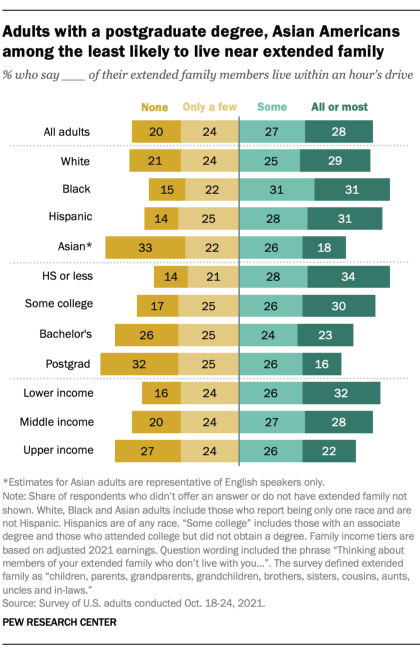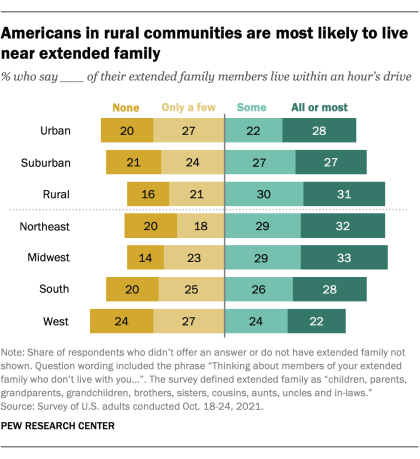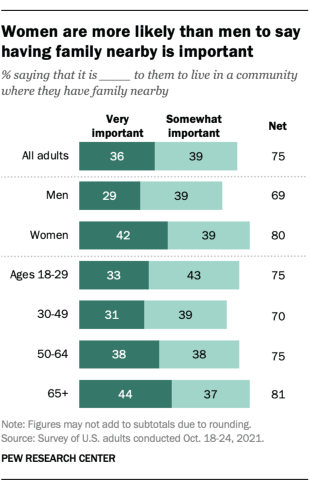

Most Americans value living close to their families – and more than half of them actually do, according to a recent Pew Research Center survey.
Overall, 55% of U.S. adults say they live within an hour’s drive of at least some of their extended family members. Roughly equal shares of Americans say they live near all or most of their extended family (28%) or near some extended family (27%). Another 24% of adults say they live within an hour’s drive of only a few family members, while one-in-five say they do not live near any extended family members. Only 1% of Americans say they don’t have extended family at all, according to the survey, which defined extended family as children, parents, grandparents, grandchildren, brothers, sisters, cousins, aunts, uncles and in-laws who don’t currently live with the respondent.
Those with the highest education levels are the least likely to live close to extended family. About four-in-ten adults with a postgraduate degree (42%) have at least some extended family members within an hour’s drive, compared with 48% of those with a bachelor’s degree, 56% of those with some college experience and 63% of adults with a high school diploma or less education. About a third of adults with a postgraduate degree (32%) do not live near any extended family, compared with 14% of those with a high school education or less.
Pew Research Center conducted this analysis to study the shares living near extended family across demographic groups and the overall importance of having family nearby to Americans. To do this, we surveyed 9,676 U.S. adults from Oct. 18 to 24, 2021. Everyone who took part is a member of the Center’s American Trends Panel (ATP), an online survey panel that is recruited through national, random sampling of residential addresses. This way nearly all U.S. adults have a chance of selection. The survey is weighted to be representative of the U.S. adult population by gender, race, ethnicity, partisan affiliation, education and other categories. Read more about the ATP’s methodology.
Here are the questions used for the report, along with responses, and its methodology.
Having extended family nearby also differs by income status. Adults with lower and middle incomes are more likely than upper-income adults to live near at least some extended family. In contrast, upper-income adults are the most likely to say they live near no extended family. Roughly one-quarter of upper-income adults say this (27%), compared with 20% of middle-income and 16% of lower-income adults.

Asian Americans are less likely than White, Black and Hispanic adults to be living near all or most of their extended family: 18% of Asian adults say this, compared with about three-in-ten in each of the other groups. Asian adults are also the most likely to say they live near none of their extended family (33%). This could be due in part to the high share of Asian American adults (75%) who were born in another country and whose extended families may still be living there. Adults born in another country or in Puerto Rico and the other U.S. territories (25%) are more likely than those born in the United States (19%) to say none of their extended family members live nearby.
There are notable regional differences across the U.S. in the shares of adults who live near at least some family, with adults in the Northeast and Midwest being the most likely to do so (62% each). Slightly more than half of adults in the South (53%) say they live near at least some extended family, while fewer than half of adults in the West (46%) say the same.

Adults living in rural communities are more likely than those in urban or suburban communities to live near at least some extended family. Roughly six-in-ten adults in rural communities (62%) say they are within an hour of all, most or some of their extended family, compared with 54% of adults in suburban areas and 50% in urban areas.
Adults ages 50 to 64 are more likely than other age groups to live within an hour of extended family. Six-in-ten adults ages 50 to 64 live near at least some extended family, compared with 53% of those 18 to 29, 52% of those 30 to 49 and 55% of those 65 and older.
Adults in multigenerational households, who already live with some family members, are more likely than adults in other types of households to live near at least some extended family. In addition to the family members they live with, some 64% of adults in multigenerational households live within an hour’s drive of at least some extended family, compared with 53% of adults who do not live in multigenerational households.
Adults in the so-called “sandwich generation” are also more likely to live near family. These are adults who have a parent age 65 or older and are raising at least one child younger than 18 or providing financial support to an adult child. Roughly six-in-ten adults in the sandwich generation live close to at least some extended family, compared with a slightly smaller share of adults not in the sandwich generation (54%).

An overwhelming majority of Americans value having family close by, according to the same survey. Three-quarters of adults say it is at least somewhat important to them personally to live in a community where family is nearby, including 36% who say it is very important. Those who value having family nearby often do live near their relatives: Some 62% of adults who say living near family is at least somewhat important to them live near some or more of their extended family members. In contrast, 34% of adults who say having family is not too important or not important at all live near at least some extended family.
Research has shown that living near extended family is linked to real-life economic impacts. In particular, married women with young children are more likely to work or be in the labor force if they live near their mothers or mothers-in-law, as child care can often be a challenge for working parents. Additionally, informal caregiving by adult children for their aging parents helps decrease medical expenses and is often preferred by the elderly over formal care.
The value that Americans place on having family nearby varies by gender and age. Women are more likely than men to say that having family nearby is very important (42% vs. 29%), although roughly equal shares of men and women say they actually do have at least some extended family nearby (57% of women and 54% of men say this). Among adults who live near at least some extended family, half of women say living in a community with family nearby is very important, compared with roughly four-in-ten men (38%).
Adults 65 and older are the most likely to say having family nearby is very important to them personally. More than four-in-ten (44%) say this, compared with 38% of adults ages 50 to 64, 33% of those 18 to 29 and 31% of those 30 to 49.
Note: Here are the questions used for the report, along with responses, and its methodology.
"Hour" - Google News
May 18, 2022 at 11:02PM
https://ift.tt/Fy87NEO
More than half of Americans live within an hour of extended family - Pew Research Center
"Hour" - Google News
https://ift.tt/e5Idguy
https://ift.tt/z3sB7ZR
Bagikan Berita Ini














0 Response to "More than half of Americans live within an hour of extended family - Pew Research Center"
Post a Comment